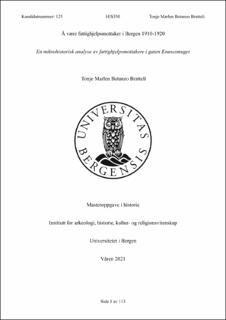Å være fattighjelpsmottaker i Bergen 1910-1920: En mikrohistorisk analyse av fattighjelpsmottakere i gaten Knøsesmuget
Master thesis
Permanent lenke
https://hdl.handle.net/11250/2761434Utgivelsesdato
2021-06-16Metadata
Vis full innførselSamlinger
- Master theses [240]
Sammendrag
Oppgaven tar for seg en kohort av voksne fattighjelpsmottakere i Knøsesmuget som følges i årene 1910-1920, med særlig vekt på årene 1913-1918. Dette er et tema som først ble utformet med utgangspunkt i fattighjelpsmottakere som mistet stemmeretten sin grunnet paragraf 52 d i grunnloven, en lovgivning vedlagt i Grunnloven i 1989 som tilsa at man mistet sin rett til å stemme ved å ha tatt imot fattigunderstøttelse. Dette utviklet seg deretter til å først og fremst ta for seg fattighjelpsmottakere, hva som karakteriserte en fattighjelpsmottaker og hvorvidt det forekom endringer knyttet til det å være fattighjelpsmottaker, i en tid da det norske samfunnet opplevde sosialpolitiske endringer, i tillegg til å være preget av første verdenskrig. Var det å være fattighjelpsmottaker statisk eller kom noen seg ut av det? Hva hadde det å være fattighjelpsmottaker å si for deres politiske medborgerskap? Dette er noen av spørsmålene som oppgaven tar for seg In this thesis I have analyzed and examined those who received poor relief in Bergen during the beginning of the 20th century, and especially during the First World War. This was a time when the Norwegian society went through a change in their view and political handling of the poor. It went from a view of poor people’s fate as being their own responsibility to a view of their fate being a collective responsibility. This started a process of municipal measures to prohibit more and more people from having to receive poor relief. The specific people I have analyzed lived in the street Knøsesmuget, a typical old working class street of Bergen. I have specifically analyzed their journey and what it means to receive poor relief in terms of their work status, family life and the individual intensity and length of the poor relief. The research questions that the study examines are the following: Who were the people that received poor relief in Bergen during the sociopolitical changes in society in the beginning of the 20th century? Were they stuck in the poor relief programme or did they get out? What were the consequences of them receiving poor relief, and how did it affect their political membership?
